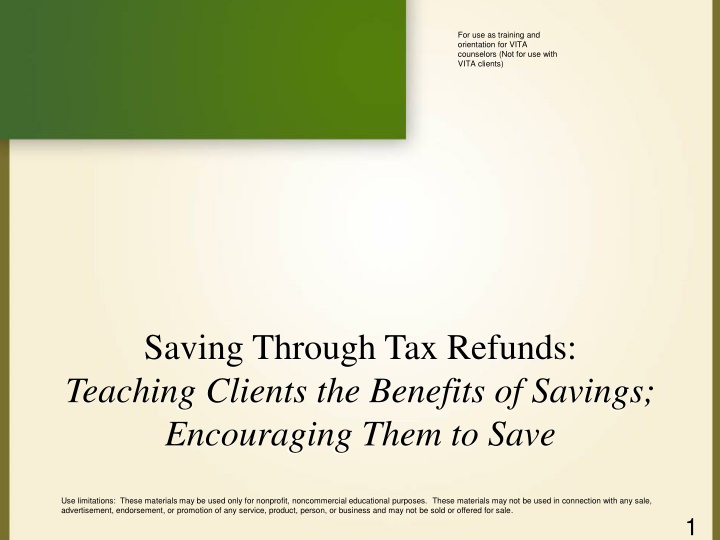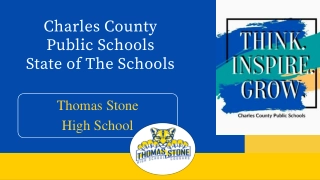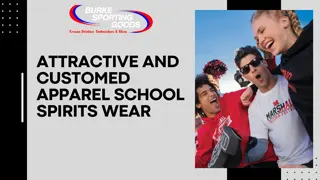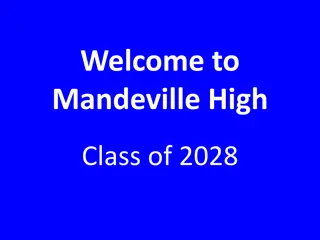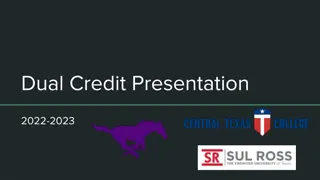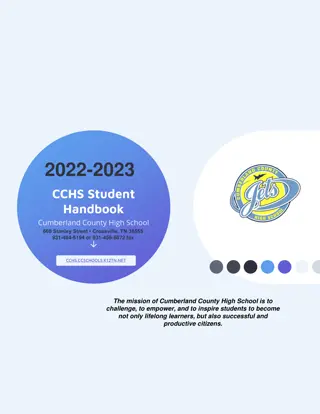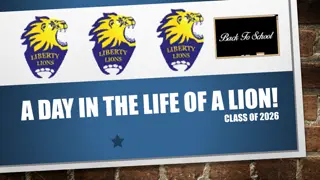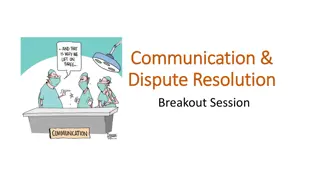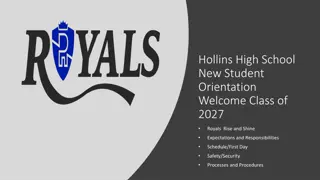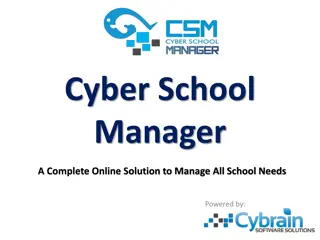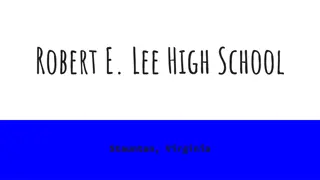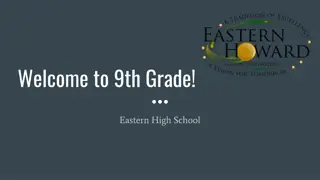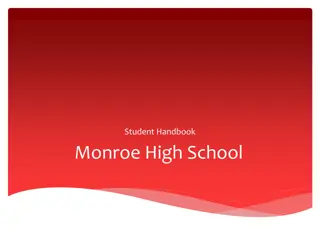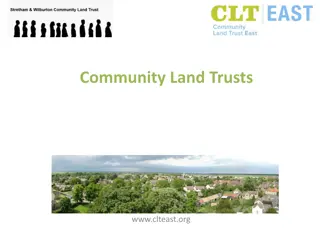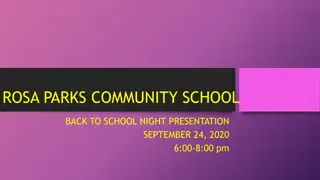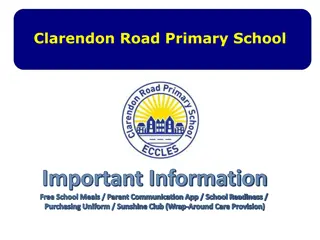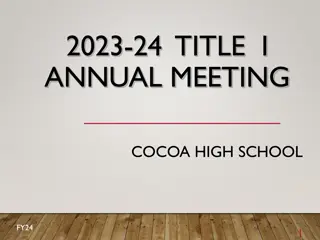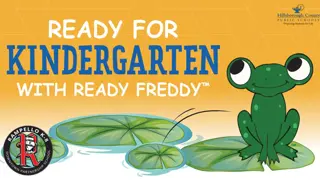Community High School Information
This information provides details about Community High School in Sterling Heights, MI, including graduation requirements, credit expectations for each grade level, credit recovery options, student performance examples, elective opportunities, and other resources available to students.
Download Presentation

Please find below an Image/Link to download the presentation.
The content on the website is provided AS IS for your information and personal use only. It may not be sold, licensed, or shared on other websites without obtaining consent from the author.If you encounter any issues during the download, it is possible that the publisher has removed the file from their server.
You are allowed to download the files provided on this website for personal or commercial use, subject to the condition that they are used lawfully. All files are the property of their respective owners.
The content on the website is provided AS IS for your information and personal use only. It may not be sold, licensed, or shared on other websites without obtaining consent from the author.
E N D
Presentation Transcript
For use as training and orientation for VITA counselors (Not for use with VITA clients) Saving Through Tax Refunds: Teaching Clients the Benefits of Savings; Encouraging Them to Save Use limitations: These materials may be used only for nonprofit, noncommercial educational purposes. These materials may not be used in connection with any sale, advertisement, endorsement, or promotion of any service, product, person, or business and may not be sold or offered for sale. 1
Program Overview Message Adopting saving habits is a process. Before building assets (saving money), clients may need success in other areas of their lives. Clients may want to: Purchase a car to get to a better job. Visit a doctor to improve a health condition. Live in a better neighborhood with better schools. Pay off debt. Take any action that will lead clients to improve their financial well-being and eventually to build assets. 2
Objectives Main workshop topics: Identify basic financial skills. List the benefits of saving money. Designate the next steps to create a savings plan. 3
Objectives (continued) Specific workshop topics: Identify the benefits of using banks and credit unions. Avoid high-cost financial services. Get started using a tax refund as a savings vehicle. 4
Program Overview Your Role When meeting with clients, your role is to: Guide clients further down their paths to financial well-being. Encourage them to start saving now with their tax refunds. 5
Program Overview Audience Live paycheck-to-paycheck and have little-to-no room for error in financial decision making. Tend to be unbanked (using alternative financial services or AFS only) or underbanked (using a combination of AFS and mainstream financial services). 6
Program Overview Audience (continued) Understand that using AFS is expensive. Use AFS for immediate relief to financial emergencies. Some may not know lower-cost alternatives are available through financial institutions. 7
Program Overview VITA Client Demographics Majority are single women with children. Age range somewhat evenly split among 20-, 30-, 40-, 50-, and 60-year-olds. 8
Program Overview VITA Client Demographics Caucasian: 42 percent African American: 27 percent Hispanic or Latino: 22 percent Asian/Pacific Highlander: 5 percent American Indian/Alaskan Native: 1 percent 9
Identify Spending Leaks Some typical spending leaks: Soda, energy drinks, coffee Dining out Fast food Vending machines Habits (cigarettes, alcohol, lottery tickets) Downloads (ringtones, games, apps, videos) 10
Create a Spending Plan Main components of a spending plan: Identify income sources. List expenses. Compare expected income and expenses. Compare actual income and expenses. Make necessary changes. 11
Create a Spending Plan (continued) Pay yourself first. Before paying bills, save some money from every source of income: Paychecks Bonuses Cash gifts Income tax refunds 12
Possible Client- Meeting Outcomes Raise awareness of how money is spent and identify spending leaks. Learn from poor choices made in the past. Convey the big picture of personal finances and create a spending plan (budget). 13
Set SMART Financial Goals A SMART financial goal is: Specific Measurable Achievable Realistic Time bound 14
Identify Benefits of using Banks and Credit Unions Convenience Security Low-cost Help establish credit history 15
Avoid High-Cost Financial Services Check-cashing stores Payday lenders Pawnshops Tax refund anticipation loans (RALs) Rent-to-own stores 16
Possible Client- Meeting Outcomes Compare the costs of AFS to mainstream financial services. Compare VITA services to refund anticipation loans (RALs). Raise awareness of Individual Development Account (IDA) programs for saving. 17
Possible Client- Meeting Outcomes (continued) Use IRS Form 8888 to allow clients to deposit a refund in three separate accounts and purchase saving bonds. Help client open a savings account and save part of a refund. 18
Possible Client- Meeting Outcomes (continued) Get clients to use direct deposit for their refunds. Ask if client wants to purchase savings bonds. Illustrate how saving even small amounts adds up over time. Remind clients they can start saving anytime not just at tax time. 19
Client Meetings The Process 1. Conduct client interviews while you review the intake form and before you begin completing the tax return. An interview script is provided for the workshop. The script is a guide to customize to each client s needs. 20
Client Meetings The Process (continued) Pick scenarios in the script to discuss with clients based on how they answer initial questions about saving. Review and complete activities with clients. 21
Client Meetings The Process (continued) 2. Complete the client s tax return. 3. Reiterate financial or savings goals. 4. Implement what you and your client discussed one of the possible Client-Meeting Outcomes. 22
Client Meetings Preparation To better understand your clients, read The CFSI Underbanked Consumer Study included with your program handout. Become familiar with Possible Client-Meeting Outcomes before you begin conducting interviews.
Client Meetings Preparation (continued) Become familiar with the activities included with the workshop materials. Because of time constraints, you may have to pick and choose parts of the activities to go over with your clients or even send them home with them. 24
Get StartedUsing a Tax Refund as a Savings Vehicle Direct deposit from the IRS into checking or savings account Split refund IRS Form 8888 deposits money into up to three accounts Individual Development Account (IDA) dollar- matched accounts for specific financial goals 25
Government Savings Bonds Clients can invest part of their refund in a savings bond. They might be thinking: I do not have a bank account so I do not have access to certain savings vehicles. I do not understand or trust complex saving and investing tools. I need a trusted savings method that does not require a large initial amount. To invest in a savings bond: Low $50 minimum. No credit screen. Purchase a bond through their federal tax return using IRS Form 8888. 26
Government Savings Bonds (continued) Risk-free principal. Government backing. No fees, solid return. Bank account not required. Earn interest for 30 years. Can access after 12 months. 27
Government Savings Bonds (continued) Buying bonds promotes saving. Add co-signers, such as children or grandchildren. Easy to access when the money is needed. Speak with your tax preparer. VITA representatives can help as well. 28
Prepaid Cards Work very much like a debit card. Require sufficient funds in the account to make purchases. Not really credit cards at all, but can be used like them. Typically used when recovering from bankruptcy or while repairing credit. Encourage clients to use these if they cannot get credit cards. 29
Questions? 30
Resources IRS VITA program: www.irs.gov (search for VITA) Individual Development Accounts/Corporation for Enterprise Development: www.cfed.org 31
